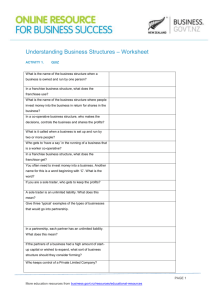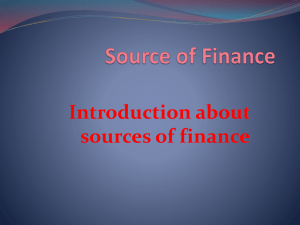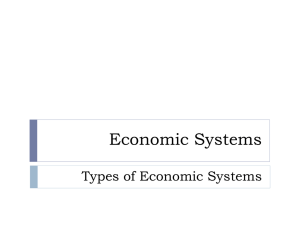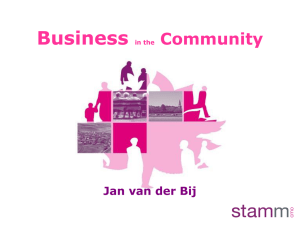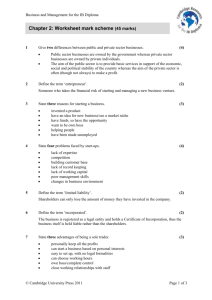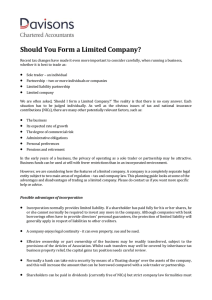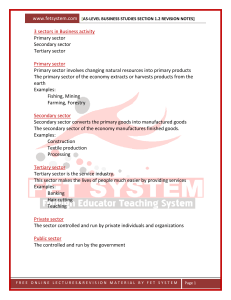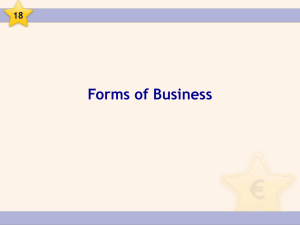Understanding Business Structures Lesson Outline
advertisement
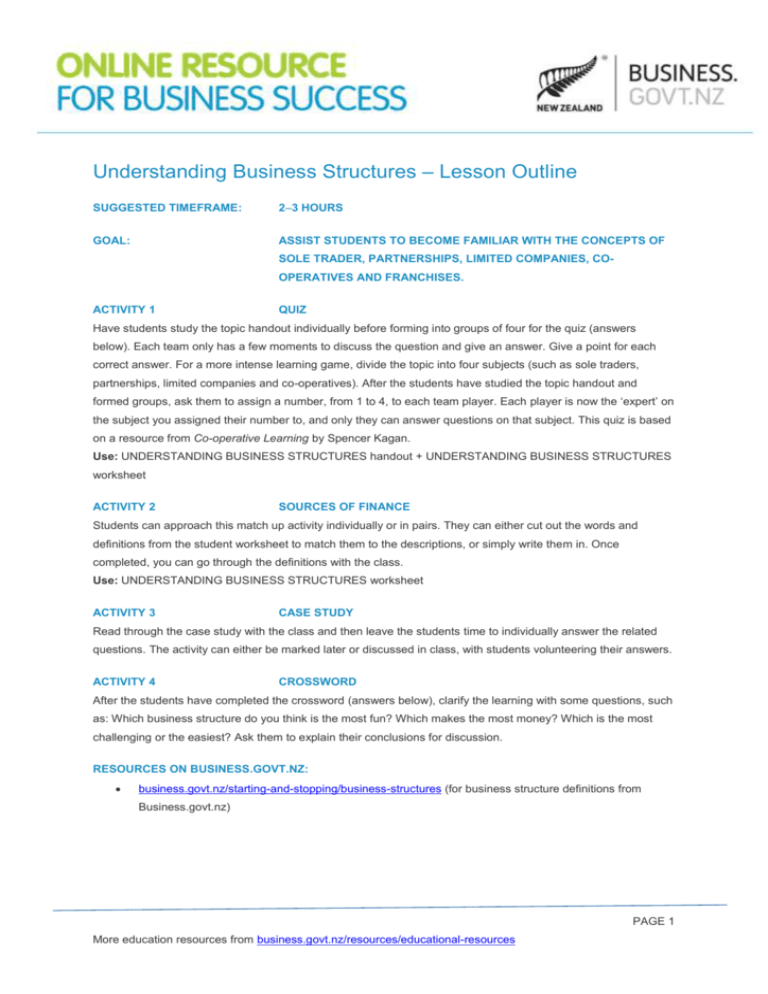
Understanding Business Structures – Lesson Outline SUGGESTED TIMEFRAME: 23 HOURS GOAL: ASSIST STUDENTS TO BECOME FAMILIAR WITH THE CONCEPTS OF SOLE TRADER, PARTNERSHIPS, LIMITED COMPANIES, COOPERATIVES AND FRANCHISES. ACTIVITY 1 QUIZ Have students study the topic handout individually before forming into groups of four for the quiz (answers below). Each team only has a few moments to discuss the question and give an answer. Give a point for each correct answer. For a more intense learning game, divide the topic into four subjects (such as sole traders, partnerships, limited companies and co-operatives). After the students have studied the topic handout and formed groups, ask them to assign a number, from 1 to 4, to each team player. Each player is now the ‘expert’ on the subject you assigned their number to, and only they can answer questions on that subject. This quiz is based on a resource from Co-operative Learning by Spencer Kagan. Use: UNDERSTANDING BUSINESS STRUCTURES handout + UNDERSTANDING BUSINESS STRUCTURES worksheet ACTIVITY 2 SOURCES OF FINANCE Students can approach this match up activity individually or in pairs. They can either cut out the words and definitions from the student worksheet to match them to the descriptions, or simply write them in. Once completed, you can go through the definitions with the class. Use: UNDERSTANDING BUSINESS STRUCTURES worksheet ACTIVITY 3 CASE STUDY Read through the case study with the class and then leave the students time to individually answer the related questions. The activity can either be marked later or discussed in class, with students volunteering their answers. ACTIVITY 4 CROSSWORD After the students have completed the crossword (answers below), clarify the learning with some questions, such as: Which business structure do you think is the most fun? Which makes the most money? Which is the most challenging or the easiest? Ask them to explain their conclusions for discussion. RESOURCES ON BUSINESS.GOVT.NZ: business.govt.nz/starting-and-stopping/business-structures (for business structure definitions from Business.govt.nz) PAGE 1 More education resources from business.govt.nz/resources/educational-resources ACTIVITY 1 QUIZ QUESTIONS AND ANSWERS What is the name of the business structure when a business is owned and run by one person? Sole trader In a franchise business structure, what does the The business idea and the name of the franchisee use? business What is the name of the business structure where people invest money into the business in return for shares in the Limited company business? In a co-operative business structure, who makes the decisions, controls the business and shares the profits? What is it called when a business is set up and run by two or more people? Who gets to ‘have a say’ in the running of a business that is a worker co-operative? Everyone Partnership Everyone In a franchise business structure, what does the A fee for the franchise and a percentage of franchisor get? the franchisee’s profits You often need to invest money into a business. Another name for this is a word beginning with ‘C’. What is the Capital word? If you are a sole trader, who gets to keep the profits? The sole trader A sole trader is an unlimited liability. What does this The owner is responsible for the debts of mean? the business Give three ‘typical’ examples of the types of businesses that would go into partnership? Solicitors Accountants Estate agents In a partnership, each partner has an unlimited liability. Each partner is personally liable for the What does this mean? debts of the business If the partners of a business had a high amount of start- A limited company (The teacher can explain up capital or wished to expand, what sort of business why this would be, based on the notes structure should they consider forming? provided.) Who keeps control of a Private Limited Company? Shareholders The public Who can buy shares in a Public Limited Company? Other businesses Financial institutions PAGE 2 More education resources from business.govt.nz/resources/educational-resources ACTIVITY 2 ANSWERS Borrowing a sum of money that then has to be repaid with interest over a period LOAN of time, usually in fixed instalments, e.g., repay $100 a month for three years. Borrowing money from a bank by drawing more money than is actually in a current account. Interest may be charged on the overdraft, some banks offer OVERDRAFT interest-free overdrafts. The bank has the power to recall the overdrawn amount at any time. MORTGAGE A loan where property is used as security. Legally renting equipment prior to buying it. Pay a fixed amount over a certain HIRE PURCHASE period of time, e.g., two years at $500 per month. The asset is not owned until the final payment is made. Renting equipment or premises. The asset is never owned but the leasing LEASING company are usually responsible for maintenance and repairs. Plc’s can sell shares in the company to raise additional finance. The investor’s SHARE ISSUE reward is dividends. A long-term loan to a business, normally between five to 25 years. Interest is paid DEBENTURE on loan. Funds given to businesses that do not have to be repaid. Normally provided by GRANTS government agencies. This is when a company sells off its equipment or property to raise money, and SALE OF ASSETS then usually hires them from another company. Part of the profit made remains in the business for the future accounting period, RETAINED PROFIT e.g., the next year. PAGE 3 More education resources from business.govt.nz/resources/educational-resources CROSSWORD ACTIVITY ON PARTNERSHIPS – ANSWERS ACTIVITY 4 1D 2P A R T N E A P I 3S S E L D E O 4T F W 5P 6C R R O W E F I N R G A L Q U T T S Y P A T N N 7E A L R S H I P PAGE 4 More education resources from business.govt.nz/resources/educational-resources
